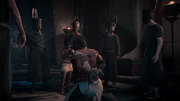
|
Patience, brothers. Soon we will reveal the secrets of Assassin's Creed: Origins (comic). This article has been identified as being out of date. Please update the article to reflect recent releases and then remove this template once done. |
{{Faction Infobox
|name = Order of the Ancients
|image = Order of the Ancients logo.png
|founder = Smenkhkare
|locations = Egypt[1]
Greece[2]
Rome
|related = Children of Cain (past incarnation)
Templars (future incarnation)
Cult of Kosmos(Contemporary Greek counterpart)
Ptolemaic Kingdom
Roman Empire
Gabiniani
|formed = Around 1334 BCE
|notable = *Flavius Metellus
- Lucius Septimius
- Julius Caesar[3]
- AugustusCite error: Closing
</ref>missing for<ref>tag
History
The Order of the Ancients was founded by the Pharaoh Smenkhkare around 1334 BCE, with the aim of identifying and exploiting ancient Isu technologies. Having discovered the Isu vault Eeyoo Sekedoo Aat, Smenkhkare eventually had his own tomb connected to the vault in order to keep it hidden. By the mid-1st century BCE during the Ptolemaic dynasty, Flavius Metellus served as one of its leader and various members of the Order held high ranking positions and titles within the regime, including Eudoros, Pothinus, and Berenike. At some point, they also obtained an Apple of Eden, the secrets of which they sought to unlock.[1]
When the young Ptolemy XIII ascended to the throne as co-ruler of Egypt alongside his sister-wife Cleopatra in 51 BCE, the Order quickly became the true power behind the throne and used all their powers to influence, through Ptolemy, the organization of Egyptian society and to push forward their own plans for the realm.[4]
After discovering that the Queen was not as easy to handle as her brother, the Order instigated the expulsion of Cleopatra from Egypt in 49 BCE. They chose Ptolemy, knowing that Cleopatra was a much more cunning ruler and a better strategist than her younger brother, who was more interested in the superficiality of power and was easily swayed by them.[4] At some point, the Order of the Ancients discovered a vault beneath the Temple of Amun in Siwa, which they believed to be connected to the Apple in their possession. Given said belief, several of the Order's members journeyed to the vault in 49 BCE, and attempted to unlock its mysteries. They kidnapped the Medjay Bayek and his son Khemu, bringing them to the vault entrance, believing them to either know something about the vault, or be able to open it. The Order had figured out that the Apple was one part of the key, and apparently believed the Medjay bloodline to be the other part.[5]
As it turned out, their attempts were in vain; Bayek, nor his son had knowledge regarding the vault, nor did the vault door react when they placed the Apple in Khemu's hands. Before they could further interrogate the Medjay, they were interrupted by the news of Ptolemy XIII's awakening, and of his desire to come to the Temple of Amun. Most of the Order members present left, leaving Bayek and Khemu within the chamber, telling them to open the door. With Khemu's aid, Bayek freed himself and attempted to fight off the Order, though Khemu was killed in the process.[5]
Having failed to open the vault, the Order abandoned their search and left the village. They appointed Medunamun, who used the cryptonym the Ibis and served as the Oracle of Amun in the temple, to remain in the village, giving him the Apple in order for him to learn more about the relic.[6] Later that year, Bayek went on a quest of vengeance against the Order, seeking revenge for his son's death. In 48 BCE, he located Rudjek, the Nomarch of Saqqara Nome and a member of the Order who went by the cryptonym the Heron, hunting him to the Bent Pyramid. Bayek knocked out Rudjek's personal bodyguard, cornering Rudjek in the tomb. Rudjek attempted to retaliate by throwing a knife at the Medjay, who blocked it with Rudjek's mask. Bayek shoved the mask into Rudjek, killing him with the blade embedded in it.[7]
Sometime later, Medunamun was assassinated by Bayek, who had returned to Siwa after his assassination of Rudjek, taking the Apple from the priest.[5] In the same time frame, Aya of Alexandria, Bayek's wife, also began her own quest to hunt down her son's killer. She enlisted the aid of Apollodorus, Cleopatra's follower, to locate the members. She eventually located Actaeon and Ktesos, two members of the Order who operated in Alexandria. For her actions, she was declared wanted by the city's Phylakitai, Gennadios, who worked with another member and the Royal Scribe, Eudoros.[8]
Eventually, Bayek and Aya learned that the men they had thought to be responsible for Khemu's death were merely a part of a much larger conspiracy to control all of Egypt through power. As a result, they later founded the Hidden Ones, an organization which would eventually evolve into the Assassin Brotherhood and fight against the next iteration of the Order of the Ancients in the following millennia, the Templar Order.[1]
Overview and ideology
Foundations and memberships
By the time Egypt had been under the control of the Ptolemaic dynasty over one thousand years, the Order comprised of various men and women at the upper echelons of the ruling class; these individuals retained positions of power and, for the most part, were involved in political, religious, economic and military proceedings. Members of the Order of the Ancients symbolically wore identical masks, headdresses, and robes when they met in congress - a visual display of their loyalties. Each key member of the Order was responsible for their own sphere of influence within Egyptian society and they were scattered all over Egypt, due to the antiquated constraints of communication and transport.[1]
Goals and beliefs
- "I have served them and your beloved Egypt. And I'll be rewarded in the Afterlife. An eternity of drinking and whoring with my brothers."
- ―Lucius Septimius, explaining his beliefs to Aya.[src]
Unlike the residents of ancient Egypt, the Order of the Ancients, much like their future incarnation the Templars, were deistic in their faith and were not polytheistic. They did believe in the Afterlife. The Order of the Ancients also believed in the Father of Understanding.
The primary aim of the Order during the 1st century BCE was to bring back a strong dynastic power, equal to that of previous dynasties which had ruled during the glory days of Ancient Egypt, prior to the arrival of the Ptolemies. This was reinforced by the belief that the pre-existing system had been founded on order, on the divine power of the Pharaohs. In this perspective, the Order was looking for means of control, be they political, religious, military or cultural, to regain what had been lost. In addition, they also had people looking for the secrets of the past, such as the Pieces of Eden, and how to unlock said secrets' potential.[1]
Members
Ancient Egypt
- Smenkhkare (Founder)
Ptolemaic Egypt / Roman Republic
- Actaeon (The Vulture)
- Ampelius (The Administrator) [3]
- Augustus [3]
- Berenike (The Crocodile)
- Eudoros (The Hippo)
- Flavius Metellus (The Lion)
- Hetepi (The Lizard)
- Julius Caesar [3]
- Khaliset (The Hyena)
- Ktesos (The Ram)
- Livius
- Lucius Septimius (The Jackal)
- Medunamun (The Ibis)
- Pothinus (The Scorpion)
- Ptahmose (The Mason) [3]
- Raia
- Rudjek (The Heron)
- Rufio (The Leader)
- Tacito (The Executioner) [3]
- Taharqa (The Scarab)
- Theotimos
Roman Empire
Allies and puppets
Ptolemaic Egypt / Roman Republic
Roman Empire
Trivia
- Many of the members' aliases are representations of various deities in Egyptian mythology:
- The ankh that accompanies the crowned snake hieroglyph resembles the cross pattée of the Order's future incarnation, the Knights Templar.
- The serpent wears the pschent, the double crown, symbolizing the Order's desire to rule all of Egypt.
- The Order's symbol and name, The Snake, contrasts the Assassins' association with the eagle.
- The masks and associated headdress the Order members wore at their meetings were crafted with icons related to divinity and sovereignty within Egyptian mythology: the double feather crown (swty) evoked Amun, and as usual, was adorned with a solar disc and uraeus, and their masks had the braided, fake beard related to Osiris.
Gallery
Appearance
References
- ↑ 1.0 1.1 1.2 1.3 1.4 Assassin's Creed: Origins
- ↑ Assassin's Creed: Odyssey
- ↑ 3.0 3.1 3.2 3.3 3.4 3.5 Assassin's Creed: Origins - The Hidden Ones
- ↑ 4.0 4.1 Assassin's Creed Origins: Official Game Guide
- ↑ 5.0 5.1 5.2 Assassin's Creed: Origins – The False Oracle
- ↑ Assassin's Creed: Origins – The Oasis
- ↑ Assassin's Creed: Origins – The Heron Assassination
- ↑ Assassin's Creed: Origins – Aya
| |||||||||||||||||||||||||||||||||||||||||||||||||||||||






